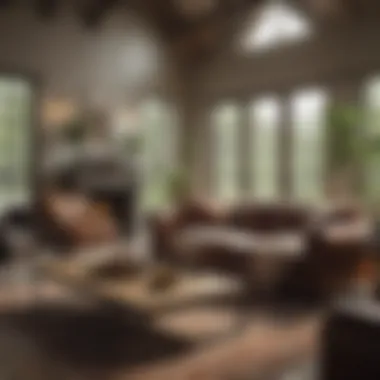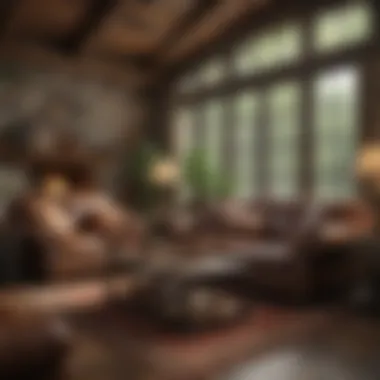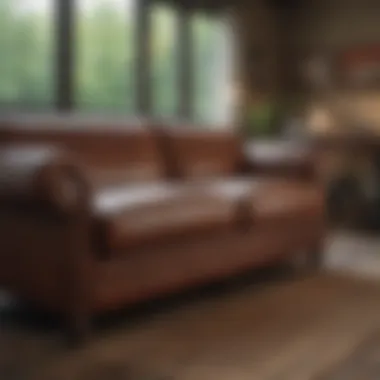Elegant Integration of Leather Couches in Farmhouse Design


Intro
This article will guide you through the essential aspects of this integration. You will find insights on design inspiration, practical tips for maintaining the leather, and advice on budgeting. By understanding the nuances of both leather furniture and farmhouse decor, homeowners can make informed decisions that reflect their personal style while ensuring functionality in their living spaces.
Design Inspiration
Trending Styles
Farmhouse style has evolved, incorporating various trends that resonate with today’s consumers. Modern farmhouse design combines sleek lines and traditional elements, providing a balanced backdrop for leather couches. Another popular trend is the industrial farmhouse, characterized by metal accents and raw finishes, which can complement the rugged texture of leather.
In contrast, coastal farmhouse decor embraces light colors and airy aesthetics, making leather sofas in warmer tones a striking focal point. By blending these styles, homeowners can personalize their spaces while reinforcing the inviting nature of the farmhouse theme.
Color Palettes
Choosing the right color palette is crucial when integrating leather couches into farmhouse interiors. Neutral tones like whites, creams, and beiges create a serene base that allows the richness of leather to stand out. Consider a warm earth-tone palette with shades of brown, olive green, or rust to create a harmonious environment.
To enhance the space, accent colors such as deep blue or muted mustard can be introduced through decor items like throw pillows or rugs. This can connect the couch with other elements in the room, ensuring a cohesive look.
"the right color palette not only sets the mood but also defines usability and comfort in farmhouse designs."
Practical Tips
Maintenance & Care
Leather couches require thoughtful care to maintain their appearance. Regular cleaning is essential. Wipe down surfaces with a soft cloth and use leather-specific cleaners to avoid damaging the material. Condition the leather every six to twelve months to keep it supple and prevent cracking.
Avoid placing leather couches in direct sunlight, as UV rays can fade colors and dry out the material. By taking these maintenance steps, homeowners can ensure their furniture remains stylish and durable for years to come.
Budgeting & Planning
Budgeting for a leather couch can vary significantly based on quality and size. It is essential to set a realistic budget that considers not only the purchase price but also ongoing maintenance costs. Investing in quality leather may have a higher upfront cost, but it often translates to longer-lasting furniture.
When planning, consider the overall layout of the space. Measure the intended area to ensure the couch fits well and allows for comfortable movement within the room.
For those on a tighter budget, look for second-hand options or shop at outlets that specialize in leather furnishings. These choices can still yield high-quality products without the hefty price tag.
Understanding Farmhouse Style
Understanding farmhouse style is a foundational step in effectively integrating leather couches into this design aesthetic. The essence of farmhouse style lies in its ability to merge comfort with functionality, offering a tranquil environment that encourages togetherness. By grasping the key elements of this decor style, one can ensure a cohesive and inviting atmosphere in their home. Moreover, such understanding assists in selecting appropriate furniture pieces that do not just fill space, but enhance the overall aesthetic.
Farmhouse style is more than just a design trend; it embodies a lifestyle that values simplicity, warmth, and practicality. This section elucidates the essential components of farmhouse aesthetics and articulates how they apply to leather couches.
Defining Farmhouse Aesthetics
Farmhouse aesthetics can be defined by a mix of rustic and modern elements that evoke a sense of nostalgia and simplicity. This style often incorporates open spaces filled with natural light and practical furnishings. The use of down-to-earth colors and materials plays a vital role in creating this ambiance. Leather couches, when correctly integrated, can complement these aesthetics by providing a rich texture that contrasts with the more rustic components commonly found in farmhouse settings.
Key Elements of Farmhouse Design
Natural Materials
Natural materials are at the heart of farmhouse design. Elements such as wood, stone, and linen create an organic feel that resonates with the outdoors.
- Key characteristic: The emphasis on sustainability makes natural materials a popular choice.
- Benefits: They bring warmth and durability to a space. Wood beams, for instance, often serve as focal points in a room, harmonizing beautifully with leather couches.
- Unique feature: The textures of natural materials can create an interesting contrast, enhancing visual appeal. However, they may require more maintenance to preserve their look over time.


Neutral Color Palettes
Neutral color palettes are essential in farmhouse design as they provide a calm and soothing backdrop. Shades of beige, white, and gray are prevalent.
- Key characteristic: These colors promote a serene atmosphere and can seamlessly blend with various design elements.
- Benefits: A neutral palette allows leather couches to stand out while still fitting into the overall scheme.
- Unique feature: Their understated nature can easily adapt to changing decor styles, though excessive neutrality might risk an uninviting feel if not complemented with decorative accents.
Vintage Accents
Vintage accents add personality and history to the decor. Items such as reclaimed wood furniture, distressed finishes, and retro decor pieces enhance the farmhouse aesthetic.
- Key characteristic: These accents tell stories of the past, contributing to a rich, layered design.
- Benefits: They provide character to a space, making it feel lived-in and warm. Leather couches paired with vintage throw pillows or accessories can create a harmonious blend of old and new.
- Unique feature: Vintage elements possess distinct charm, but finding authentic pieces can sometimes be challenging or costly.
Historical Context of Farmhouse Style
The historical context of farmhouse style begins in rural America, where practicality was paramount. Early settlers designed their homes with functionality in mind, utilizing local materials and creating spaces that supported family life. Over time, this style evolved, absorbing influences from various periods and cultures. The modern interpretation of farmhouse design reflects this historical evolution by fusing traditional influences with contemporary trends. This context serves as a reminder of the enduring appeal of farmhouse design and highlights the importance of thoughtful integration, particularly when introducing leather couches into the mix.
Leather Couches: An Overview
Leather couches represent a significant addition when considering farmhouse style design. Their inherent qualities enhance both aesthetic appeal and practical functionality within living spaces. The combination of leather with the rustic charm of farmhouse decor can create a sophisticated yet cozy atmosphere. It's essential to understand the various types of leather, their benefits, and how they fit into the overall theme of farmhouse interiors. This overview section serves as the foundation for appreciating leather couches in this context.
Types of Leather and Their Qualities
Full-Grain Leather
Full-grain leather is widely regarded as the highest quality leather available. The unique characteristic of this leather lies in its unaltered surface, which retains all the natural imperfections of the hide. This not only gives it a distinctive, authentic look but also enhances its durability. The presence of all the natural grain also means that the leather develops a rich patina over time, making it even more appealing. For homeowners aiming for authenticity in their farmhouse design, full-grain leather is a beneficial choice, as it complements rustic elements beautifully. However, it tends to be more expensive than other types.
Top-Grain Leather
Top-grain leather is the second-highest quality option and is more affordable than full-grain leather. This leather is created by sanding the surface of the hide, removing imperfections and scars. It has a smooth finish and is more stain resistant, making it a popular choice for families and pet owners. Top-grain leather's quality lies in its combination of durability and affordability. Its versatile look aligns well with farmhouse aesthetics, adding a touch of sophistication without veering away from the rustic theme. However, the sanding process can make it less breathable than full-grain leather.
Bonded Leather
Bonded leather is a more budget-friendly option, made from leftover leather scraps that are bonded together with a polyurethane layer. While it may not offer the same level of durability as the other types, it still provides a leather look at a lower price point. Bonded leather can be a suitable choice for those aiming to incorporate leather aesthetics without significant financial investment. However, its lifespan tends to be shorter, and it may require more frequent replacement, which is something to consider when blending it into farmhouse design.
Benefits of Leather Furniture
Durability
Leather's renowned durability plays a vital role in its appeal as furniture material. Couches made from leather can withstand significant wear and tear, making them ideal for busy households. Unlike fabric, which can fray or stain easily, leather tends to resist damage over time. This quality means that a leather couch can remain stylish for many years, aligning well with the longevity often sought in farmhouse design. However, they do require careful maintenance to retain their best appearance.
Easy Maintenance
Leather furniture requires minimal maintenance compared to its fabric counterparts. A simple wipe-down with a damp cloth can remove most spills or dirt, which is particularly useful in a household that sees frequent gatherings or parties. Moreover, many leather types are designed to resist stains more effectively than fabrics. This characteristic not only saves time but also preserves the couch’s fresh look within a casual yet chic farmhouse environment. However, conditioning is still necessary to keep the leather supple.
Timeless Appeal
Leather possesses a timeless beauty that complements various design styles, including the classic farmhouse aesthetic. Its ability to adapt across different trends and settings makes it a versatile option for interior designs. When integrated thoughtfully, leather couches can enhance the warmth and rustic charm often present in farmhouse spaces. While some furniture trends may fade, leather's enduring appeal ensures it remains relevant, providing a cohesive look that is appealing to many homeowners.
Choosing the Right Leather for Your Space
Choosing the right type of leather is fundamental in harmonizing with farmhouse decor. Homeowners should consider factors such as lifestyle, budget, and aesthetic preference when selecting their ideal leather couch. Evaluating spaces in terms of how often they are used and the overall design theme will guide informed decisions. The balance between functionality and visual appeal can transform an ordinary space into a beautifully integrated farmhouse interior.
Harmonizing Leather Couches with Farmhouse Decor
Integrating leather couches within farmhouse decor requires careful consideration to maintain aesthetic harmony. Leather offers a sophisticated texture and durability that can elevate the rustic charm associated with farmhouse style. However, it is essential to ensure that the warmth and inviting atmosphere characteristic of this design style are not compromised. Thoughtful blending of these two elements results in a cohesive and visually balanced living space.


Color Coordination Strategies
Color plays a vital role in creating a home that feels both stylish and welcoming. Implementing strategic color choices can help to integrate leather couches seamlessly into farmhouse style.
Complementary Colors
Complementary colors are opposite on the color wheel and can create a striking visual contrast. This strategy contributes to a dynamic aesthetic, drawing the eye to the leather couch while enhancing the overall decor. For example, pairing a rich brown leather sofa with soft blue or light green walls can create a balanced look. This combination is popular because it marries the warmth of leather with the coolness of lighter tones, resulting in visual interest without overwhelming the space. However, it is important to strike the right balance; excessively bold colors can distract from the rustic charm.
Contrasting Textures
Incorporating contrasting textures is another effective strategy for harmonizing leather couches with farmhouse decor. The smooth surfaces of leather can be balanced by rougher materials like wood or denim. This interplay not only adds depth to the space but also draws attention to the varied elements within the room. By mixing leather with woven fabrics or weathered woods, homeowners create an inviting atmosphere while maintaining focus on comfort. However, too much variation in texture can lead to a disjointed feel, so it’s best to choose one or two contrasting elements to highlight.
Accent Pieces
Accent pieces are crucial in tying the overall design together. They can help bridge the gap between the leather couch and the farmhouse aesthetic. Items like rustic wall art, vintage lamps, or even greenery can complement the leather while reinforcing the farmhouse vibe. The key characteristic of accent pieces is their ability to introduce subtle color or pattern, creating a sense of unity in the decor.
Adding thoughtful accents can ensure the leather sofa does not feel out of place, but rather enhances the space’s warmth. However, over-accessorizing can clutter the look, so selecting a few curated pieces is essential to maintain clarity and focus.
Balancing Modern and Rustic Elements
Striking a balance between modern and rustic elements is pivotal in achieving a cohesive farmhouse interior. The clean lines of a contemporary leather couch can be softened by pairing it with vintage or reclaimed elements. This approach allows homeowners to enjoy the comfort of modern design while honoring traditional farmhouse sensibilities. It encourages a blended aesthetic where both styles can coexist and support each other, creating an environment that feels fresh yet rooted in history.
Integrating Accessory Textiles
Accessory textiles serve as an integral part of the decor and can enhance the comfort and visual appeal of leather couches within a farmhouse setting. The right textiles bring warmth and a touch of softness to leather's coolness.
Throw Pillows
Throw pillows offer an easy way to introduce color and pattern to a leather couch. They can be selected in fabrics like cotton or linen, which are both breathable and durable. Opting for muted colors or simple patterns can complement the leather without overwhelming it. This adds a layer of comfort while ensuring the space remains stylish. However, using too many bright or busy patterns can create visual chaos, so moderation is important.
Blankets
Blankets add warmth and texture, making them a valuable accessory for leather couches. Incorporating natural fibers like wool or cotton enhances the coziness of your space. A well-placed blanket in a neutral or earth-toned shade provides visual harmony with leather while serving a practical purpose. Nevertheless, selecting fabrics that require extensive care may diminish their appeal, so choosing easy-to-maintain textiles is a prudent choice.
Area Rugs
Area rugs can ground a space and help define areas within an open-concept layout. Choosing a rug that harmonizes with both the leather sofa and the overall farmhouse decor is crucial. Natural materials like jute or soft-woven cotton align well with farmhouse aesthetics. An area rug adds warmth and anchors the leather couch in the room. However, a large or overly ornate rug can overpower the leather and clutter the overall design, so selecting a size and design that complements the couch while maintaining balance is key.
Successfully integrating leather couches into farmhouse decor hinges on thoughtful color coordination, texture balancing, and strategic accessorizing. By focusing on these elements, homeowners can create aesthetically pleasing and functional spaces.
Sourcing and Maintaining Leather Couches
In the context of integrating leather couches into farmhouse style, sourcing and maintaining these pieces is crucial. The choice of where to purchase a leather couch sets the tone for both quality and aesthetics. Also, regular maintenance ensures longevity and keeps the couch looking its best.
Where to Purchase Leather Couches
Online Retailers
Online retailers have transformed how we shop for furniture. Their primary benefit is convenience. Customers can browse a wide selection, compare prices, and read reviews from the comfort of their home. A key characteristic of online retailers, like Wayfair or Amazon, is their extensive inventory, which includes various styles that fit the farmhouse aesthetic. Online shopping allows for easy access to multiple brands and unique leather couches. However, seeing the couch in person is not possible, which can lead to issues like size misjudgments or color mismatches. It's important to check return policies before buying.
Local Furniture Stores
Local furniture stores offer a different experience. The tactile experience of seeing and feeling the couch can be invaluable. These stores often carry high-quality pieces that may not be available online. A visit can provide insights into the craftsmanship of the leather and overall build quality. One significant advantage is the opportunity to speak with knowledgeable staff who can recommend options that fit the farmhouse style. However, the selection may be limited compared to online counterparts, and prices might be higher.
Secondhand Options
For those who appreciate character, secondhand options can be ideal. The unique aspect of secondhand leather couches is their potential for distinctive designs that add personality to the space. Thrift stores, consignment shops, or online marketplaces like Craigslist offer a range of choices. Additionally, these options are often more affordable, making them appealing to budget-conscious buyers.


However, it's essential to consider the couch's condition. Damage or wear may not be immediately visible. If choosing this route, thorough inspection and possible refurbishment are necessary to fit into the farmhouse aesthetic.
Maintenance Tips for Leather Couches
Understanding maintenance for leather couches is just as vital as sourcing them. Proper care ensures the furniture remains inviting and functional over time.
Cleaning Techniques
Regular cleaning is fundamental to preserving leather. Utilizing a soft, dry cloth can remove dust and debris, keeping the couch looking fresh. A notable characteristic of good cleaning techniques is simplicity. Solutions specifically for leather, available in many stores, can be used to maintain the finish. Avoid harsh chemicals, which can damage the leather. One must be careful, however, as improper cleaning can lead to a dull appearance.
Conditioning Leather
Conditioning leather is essential for preventing cracks and dryness. Leather conditioner works by replenishing natural oils. A key characteristic of conditioning is its preventive nature. Regular application of conditioner every six months can dramatically extend the couch's lifespan. This process is straightforward and can often be done at home. Nonetheless, one should choose high-quality products that are appropriate for the specific type of leather to avoid adverse reactions.
Preventing Damage
Preventing damage involves being mindful of the couch's environment. Key aspects include avoiding direct sunlight, which can fade colors, and controlling humidity levels. Another important aspect is ensuring pets or sharp objects do not come into contact with the leather. Awareness of these factors helps maintain the integrity of the couch. If damage does occur, immediate action is essential to remedy issues before they escalate.
"A well-maintained leather couch can become the centerpiece of your farmhouse living space, elegantly blending comfort and style."
Through mindful sourcing and diligent maintenance, leather couches can find a perfect home in farmhouse designs, offering both functionality and aesthetic appeal.
Case Studies: Successful Integrations
The integration of leather couches into farmhouse style design is not merely a trend; it is a testament to versatility. By examining successful case studies, we gain insight into how various elements can coexist harmoniously. Each study offers a unique perspective, highlighting how homeowners can navigate challenges and capitalize on opportunities presented by this fusion.
Diverse design strategies and personal preferences map the journey of integrating leather into farmhouse aesthetics. The value of these case studies lies in their practical applications and the lessons learned. They showcase real-life examples, providing inspiration and motivation for those contemplating similar design choices.
Contemporary Farmhouse Living Rooms
Contemporary farmhouse living rooms often exemplify a seamless blend of modern comforts and rustic charm. Leather couches serve as pivotal focal points within these spaces. Their natural textures and colors enhance the overall aesthetic while providing a touch of elegance.
In a notable example, a living room in a renovated barn features a sectional leather sofa paired with reclaimed wood accents. The warm tones of the leather complement the natural grain of the wood, reflecting a cohesive design language. The contrast of sleek leather and rough-hewn materials helps to anchor the space, creating a pleasing comfort zone.
Homeowners might consider arranging seating areas for conversation and relaxation. Accessories such as oversized floor cushions and neutral throw blankets can enhance the comfort factor. This arrangement invites both intimate gatherings and larger social events, making the living room not just a passage space but a central hub of activity.
Mixing Styles in Farmhouse Decor
Mixing styles within farmhouse decor involves a calculated approach to design. Here, leather couches can act as versatile pieces that bridge different influences, whether they draw from vintage, modern, or industrial domains. Consider a living room that combines a leather sofa with mid-century modern chairs and a vintage coffee table. This combination may seem unconventional but creates an engaging visual narrative.
When mixing styles, it is essential to maintain a sense of balance. One effective method is to ensure that the colors align. A dark brown leather couch can coexist with muted pastels or bold statement colors if each piece in the room provides a thread of connection.
In practice, accessories play a significant role. Layering textiles, like woven throws or patterned pillows, can easily merge different styles. This subtle addition softens contrasts and allows the space to feel more cohesive. Beyond aesthetics, such arrangements provide a comfortable and inviting atmosphere.
By analyzing these case studies, homeowners can glean insights into the art of integration. Each design detail contributes to the broader narrative of farmhouse-style living, encouraging a thoughtful exploration of personal expression while maintaining functionality.
Closure
In the realm of home design, integrating leather couches into farmhouse style is more than a trend; it represents a thoughtful blend of comfort, durability, and aesthetic appeal. This article has explored various dimensions that elevate the farmhouse aesthetic while incorporating leather furniture. Understanding the historical context and the defining characteristics of farmhouse style allows homeowners and design enthusiasts to make informed choices.
Summarizing Key Takeaways
- Versatility: Leather couches can seamlessly enhance the rustic charm of a farmhouse while providing a contemporary twist.
- Maintenance Awareness: Knowledge of proper care methods can prolong the life of your leather furniture and keep it looking its best.
- Sourcing Options: Various retail options exist for purchasing leather couches, from online platforms to local boutiques, making it accessible.
Applying these principles not only improves the aesthetic surrounding the leather couch but also enhances functionality in the living space. Each design choice made, from color selection to accessory integration, becomes an essential thread in the intricate tapestry of home decor.
Future Trends in Farmhouse Design
The future of farmhouse design points towards a harmonious blend of traditional and modern elements. Expect advancements that prioritize sustainability, such as the use of responsibly sourced leather and eco-friendly manufacturing processes. Furthermore, the integration of smart home technology will continue to rise, providing convenience without sacrificing the charm of farmhouse aesthetics.
Additionally, as minimalist design gains traction, expect a push towards simpler, more streamlined furniture choices that maintain warmth and comfort without overcrowding space. This evolution presents an exciting opportunity to reimagine how leather couches can fit into the broader narrative of farmhouse style, maintaining their status as a timeless yet modern choice for homeowners.















